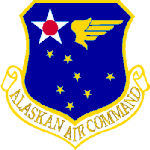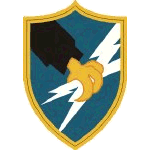


Shemya Air Force Station
The single most important factor about Shemya from the military point of view is its location. For World War II it was 2050 miles from Tokyo, and for the Cold War it was only 600 miles from one of the most heavily militarized places in the Soviet Union, the Kamchatka Peninsula.
Shemya was converted into a "fixed" aircraft carrier. A ten-thousand foot runway constructed along the south coast of the island provided the space necessary for launching heavily laden bombers for trips to Asia. Before the era of air-to-air refueling an aircraft was loaded to the design limits with fuel to make the long flights. After World War II the runway provided a fueling stop for aircraft flying across the Pole to Europe or to Asia from the United States.
Like an aircraft carrier there is no "run-off" at the ends of the runway. At the eastern end you drop into the Pacific, and at the western end you drop into a ravine. If you veer to the South you go into the water and to the North is the slope to the center of the island. Unfortunately Shemya is not able to turn "into the wind", so pilots have to deal with crosswinds more often than not.
Walking off the beaten path on Shemya can provide your life with excitement as it is possible to discover the World War II coastal artillery emplacements that tundra has since covered. You can then learn how to drive a Uke aircraft tractor to extricate the International Harvester Travel-All that you have inadvertently driven into the emplacement.
World War II also provided a variety of ordnance that is scattered all over the island. Covered by the ever growing blanket of the Tundra, such discoveries can ruin your day. There is only one sure way of cleaning up this mess, scraping everything off the rock. Of course that would destroy the environment, making the exercise pointless.
The island is primarily supplied by barge, and it is unfortunate that no one ever considered loading at least the metallic detritus on the barge after supplies have been unloaded and return it to the mainland for recycling.
Mail and other immediate needs arrived by Reeve Aleutian Airways twice a week. Reeve had upgraded to Lockheed Electra turboprops just before I arrived, and the stewardesses on the Reeve flights were the only women to set foot on the island for my entire tour.
A KC-135 landed every other week to rotate crews for the reconnaissance mission that flew from the island, and brought in limited fresh food and smaller equipment from Eielson AFB, outside Fairbanks, Alaska, 1575 miles one way.
I was assigned to the 6985th Security Squadron on Eielson AFB in the late winter of 1968. Having just finished Combat Crew survival school in the Cascade Mountains of Washington state, my first job was to take the Arctic survival course. I went from camping and snow shoeing through two feet of fresh snow at 30 degrees, to camping and hiking at minus 40 degrees.
Everyone should get video of the fun things that happen at minus 40: your moustache will break, your spare tire will shatter if you drop it from the tail gate to the ground, and clouds will develop and snow will fall in a two story stairwell that has an outside door and a door to a steam-filled mess hall. Brain damaged locals will tell you that it is not that bad because it is a "dry cold". Their cousins in Arizona will tell you that 110 degrees isn't bad because it is a "dry heat".
In the interest of accuracy water becomes a solid at 32 degrees and therefore, by definition temperatures colder than that are dry. The water vapor condenses and becomes snow and ice. You see your breathe at colder temperatures because the water vapor in your breathe is converted to ice crystals.
If you have experience in colder climes you can estimate the air temperature by the sound emitted by the snow when you walk across it. As the temperature gets colder the frequency of the sound goes higher. It also takes an increased volume of snow to produce a given volume of water.
As the 6985th was over-staffed when we arrived, two friends and I "volunteered" to take a temporary assignment with the 6984th Security Squadron at Shemya Air Force Station in the Aleutians.
While one should never volunteer in the military, Shemya was warmer than Eielson, every day at Shemya was counted as a day-and-a-half at Eielson, nasty "make work" jobs were being planned for us if we didn't go, and, having seen Eielson in the Winter, how bad could Shemya be?
Actually, it wasn't that bad if you enjoyed reading.
The 6984th was a 24/7 operation. You worked 4 day shifts, had 24 hours off, 4 evening shifts, 24 hours off, four midnights and then had 96 hours off. They called it 4-1-4-1-4-4, but if you stayed on the same shift having one shift off would be 40 hours of free time, instead of the 24 hours caused by the shift rotation. Someone figured out that it was better to have people a little disoriented that well rested and alert while trapped on the island.
You learned the survival skills: all tape recording had to be accomplished inside a metal wall locker to avoid the buzz from the radar array; don't wander around alone; the Soviet spy ships off the coast don't react to your rude gestures; someone on the island was probably making the glass fishing floats from old bottles; don't annoy the dog; don't feed the foxes [or they'll follow you home and annoy the dog]; don't disturb the Security Police patrolling the shore [as some fool gave them bullets for their guns and shooting annoys the dog], and don't inhale too deeply as you go by the Army quarters or you won't make it home.
The theater showed movies that were already regarded as classics on late night television and the shows on the closed circuit television were the worst programs from the "Golden Age".
The palette for the entire island was composed of grays, greens, dark blues, and rust. There were no dry cleaning facilities so everyone wore fatigues. The weather made exterior painting impossible, so the grays of concrete and weathered wood provided minor contrast to the grayish green tundra. The few vehicles were matte Air Force blue which was also the predominate color of the ocean. The dump was the most colorful place on the island. The rusting metal adding a highlight to the general sameness encountered elsewhere.
The bird life tended to the Arctic standard of black and white and flowers generally came and went during four weeks centered on the Summer Solstice.
The "trawlers", both those engaged in fishing and those engaged in listening, tended to be dirty white over rust red.
The Russian trawlers needed the extra bracing supplied by their antenna arrays because they always looked as if they were ready to dissolve into a mound of rust on the ocean floor. The newly arrived vessels took the trouble to deploy nets for a short while, but Arctic boredom rapidly dissuaded them from this futile pretense.
The Japanese vessels, the ones that were fishing, were considered the source of the glass balls that occasionally washed up on the beach. I would note that the "floats" were almost always beer bottle brown or beer bottle green. It is of course possible that the Japanese made their floats from old beer bottles, but I was always suspicious of the late night activities in the hobby shop.
Legally there is a three-mile limit off the coast of a country. That limit has been extended to twelve miles by a consensus of nations, but most countries claim much more territory off their coasts in an effort to grab as much of the animal and mineral wealth of the oceans as possible.
The trawlers sailed wherever they felt like, because by the time the Coast Guard could come over from Attu, they would have finished their pass and be out in international waters again.
They were brave people as there were constant rumors of the Security Police shooting seals they had mistaken for Soviet frogmen sneaking ashore. The seals may have been trying to get away from killer whales and other large animals scrambling to avoid the submarines in the trench south of the island chain.